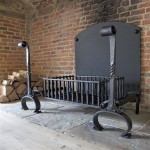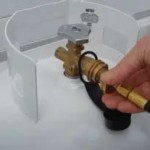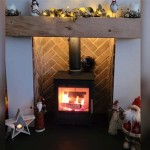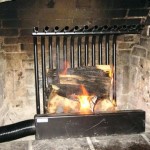Stone Fireplace With Wood Mantel and TV: A Comprehensive Guide
Incorporating a stone fireplace with a wood mantel and a television above it presents a complex design challenge. Successful integrations require careful consideration of aesthetic balance, safety regulations, thermal management, and ergonomic viewing angles. This article provides a detailed exploration of the relevant factors involved in creating such a focal point in a residential or commercial space.
Aesthetic Considerations in Design
The visual appeal of a stone fireplace with a wood mantel and a television is paramount. Selecting the right type of stone, wood, and television size largely determines the overall aesthetic harmony. The stone's texture, color, and pattern should complement the architectural style of the room. Natural stone options include fieldstone, river rock, ledgestone, and flagstone, each providing a distinct visual character. Manufactured stone veneers offer a more cost-effective and lightweight alternative, mimicking the look of natural stone while simplifying installation.
The wood mantel serves as a transitional element between the stone fireplace and the television. The wood species, finish, and style should coordinate with the stone and the room's decor. Options range from rustic reclaimed wood to sleek, modern hardwoods. The mantel's size and proportion are crucial; it should be substantial enough to provide visual balance without overwhelming the fireplace or obstructing the television.
Television size must be appropriately scaled to the fireplace and the room size. A television that is too large will dominate the wall, while one that is too small will appear insignificant. Consider the viewing distance when selecting the television size. A general guideline is to multiply the viewing distance in inches by 0.84 to determine the ideal screen diagonal in inches. The television’s frame color should also blend seamlessly with the surrounding materials.
Lighting plays a significant role in enhancing the visual impact. Recessed lighting, sconces, or spotlights can be strategically positioned to highlight the stone texture and the wood mantel. Dimmer switches provide flexibility to adjust the lighting levels according to the ambiance desired. Avoiding direct glare on the television screen is essential for optimal viewing.
Safety and Thermal Management
Integrating a television above a fireplace necessitates careful attention to safety and thermal management. Fireplaces generate heat, which can damage electronic components. Excessive heat can cause the television to malfunction, reduce its lifespan, or even pose a fire hazard. Mitigation strategies are therefore essential.
Maintaining adequate clearance between the fireplace and the television is crucial. Building codes often specify minimum clearance distances for combustible materials near fireplaces. These codes vary depending on the type of fireplace (wood-burning, gas, or electric) and the materials used in the construction. Consult local building regulations to ensure compliance.
Installing a heat shield above the fireplace opening can deflect heat away from the television. Heat shields are typically made of metal and are designed to redirect heat upwards and away from the wall. The size and design of the heat shield should be appropriate for the fireplace's heat output and the distance to the television.
Convection airflow is another important factor. Ensuring adequate ventilation around the television allows heat to dissipate. Installing vents above the mantel can help to promote airflow and prevent heat buildup. A professional HVAC technician can assess the airflow dynamics and recommend appropriate ventilation solutions.
Consider using a full-motion television mount. This type of mount allows the television to be pulled away from the wall when the fireplace is in use, further reducing heat exposure. The mount should be sturdy enough to support the television’s weight and allow for easy adjustment.
Regular maintenance of the fireplace is also critical. Clean the chimney and firebox regularly to prevent creosote buildup, which can increase the risk of chimney fires. Inspect the fireplace surround and mantel for signs of heat damage, such as cracking or discoloration. Promptly address any issues to prevent further damage and ensure safety.
Ergonomics and Viewing Angle Optimization
Optimizing the viewing angle of the television is essential for comfortable and enjoyable viewing. Placing the television too high can strain the neck and lead to discomfort. The ideal viewing angle is typically considered to be within 15 degrees below eye level when seated.
Determining the optimal television height involves considering the seating height, the distance from the seating area to the television, and the size of the television screen. A general guideline is to position the center of the television screen at eye level when seated. However, this is not always possible when mounting a television above a fireplace. In such cases, tilting the television downwards can improve the viewing angle.
Adjustable television mounts offer flexibility in adjusting the viewing angle. Tilting mounts allow the television to be tilted downwards, while full-motion mounts allow for both tilting and swiveling. These mounts can be particularly useful in rooms with multiple seating areas or where the viewing angle needs to be adjusted frequently.
Consider the room's acoustics when positioning the television. Sound waves can be reflected off hard surfaces, such as stone fireplaces, leading to echoes and distorted sound. Incorporating sound-absorbing materials, such as rugs, curtains, or acoustic panels, can improve the sound quality and reduce echoes. A soundbar can also enhance the audio experience, providing clearer and more immersive sound.
Cable management is another important consideration. Concealing cables and wires can improve the overall aesthetic and prevent tripping hazards. Running cables through the wall or using cable concealers can create a cleaner and more organized look. Ensure that the cables are properly secured and protected from heat and moisture.
Remote control functionality is essential for convenient operation of the television and other electronic devices. Using a universal remote control can simplify operation by controlling multiple devices with a single remote. Infrared (IR) repeaters can extend the range of remote controls, allowing them to operate devices that are hidden behind walls or in cabinets.
In summary, designing a stone fireplace with a wood mantel and a television involves a multifaceted approach. Attention to aesthetic harmony, safety regulations, thermal management, and ergonomic viewing angles is crucial for achieving a successful and enjoyable outcome. Professional consultation with architects, interior designers, and contractors is recommended to ensure that the design meets all applicable codes and standards and aligns with the client's specific needs and preferences.

Fireplace Remodeling Options Classic Home Improvements Stacked Stone Fireplaces Remodel

Newest Snap Shots Fireplace Mantels With Tv Above Popular Stone The Th Brick Mantles Home Mantle Designs

Stone Fireplace Makeover Taryn Whiteaker Designs

40 Stone Fireplace Designs From Classic To Contemporary Spaces Design Home

Dark Walnut Fireplace Mantel 60 Long X 5 Tall

Rustic Brick Fireplace With Tv In Master Bedroom Cottage

Country Style Mantels And Fireplaces Town Living

White Stone Fireplace With Gray Wash Wooden Mantel Cottage Living Room

How To Build And Hang A Mantel On Stone Fireplace Shanty 2 Chic
Debating A Modern Or Traditional Fireplace Heat Glo








